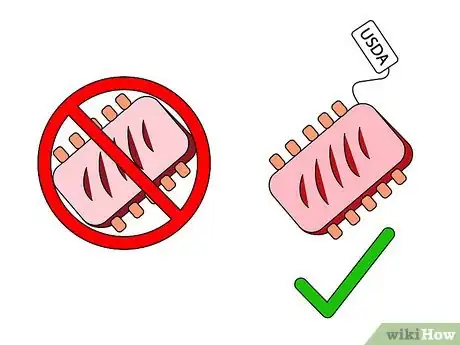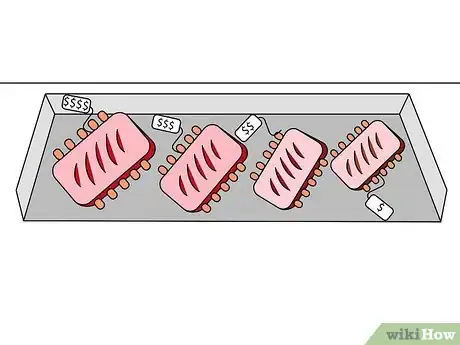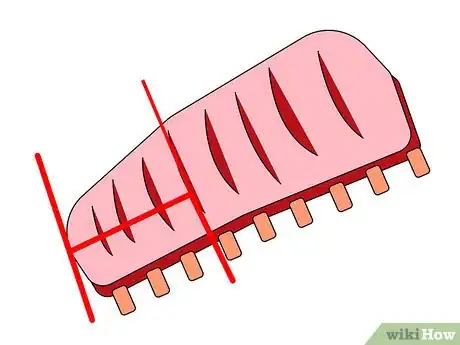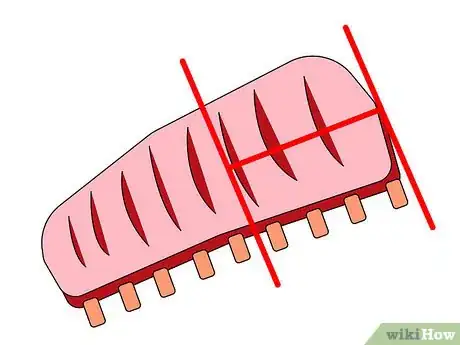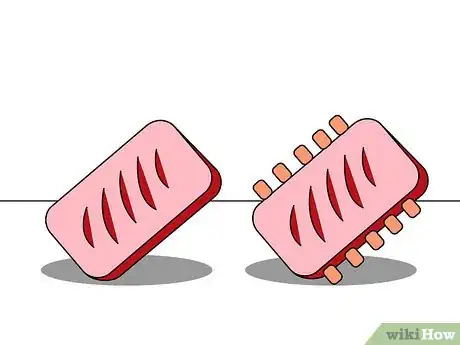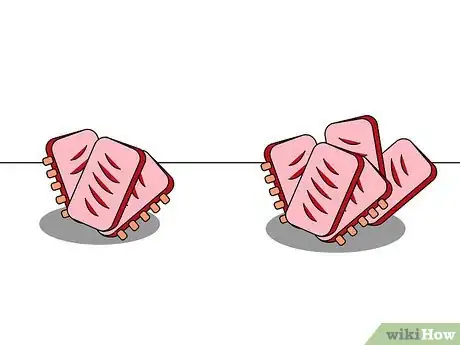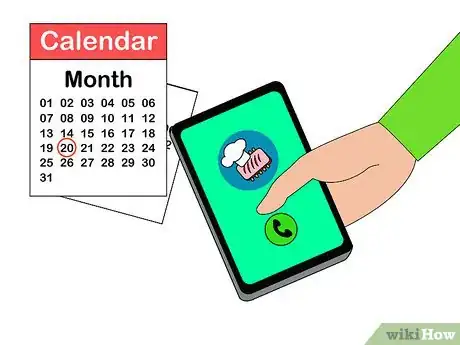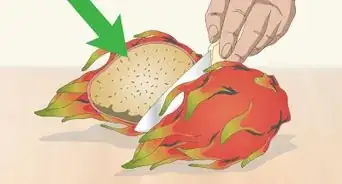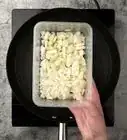This article was co-authored by wikiHow Staff. Our trained team of editors and researchers validate articles for accuracy and comprehensiveness. wikiHow's Content Management Team carefully monitors the work from our editorial staff to ensure that each article is backed by trusted research and meets our high quality standards.
wikiHow marks an article as reader-approved once it receives enough positive feedback. In this case, 95% of readers who voted found the article helpful, earning it our reader-approved status.
This article has been viewed 110,033 times.
Learn more...
Standing rib roasts are an extremely popular choice among meat connoisseurs. Deciding between USDA prime grade roasts and choice grade roasts will dictate where you purchase your meat from, while knowing how to identify quality meat will allow you to make the right decision once you are at the store. No matter what grade you decide on, standing rib roasts are a wonderful centerpiece for any dinner party or special occasion.
Steps
Picking the Roast
-
1Choose to buy a USDA prime grade roast for the best quality. As one of the two standing rib roast grades, USDA prime is the highest end meat and the most expensive. Order a USDA prime grade roast if you want a truly tender cut of beef with the highest degree of marbling, flavor, and maturity. Although prices will vary, prime grade roasts typically cost around 15 dollars per pound.[1]
- Only 2% of all beef products are USDA prime grade beef, so speaking with your butcher before entering the shop will be important to give the establishment time to prepare or order the roast for you.
- When talking with the butcher, make it clear that you are searching for prime grade beef, as many butchers and supermarket clerks will assume you are looking for choice grade if you simply ask for a prime roast.[2]
- Prime grade roasts can be difficult to find, so you will most likely need to contact a butcher rather than a supermarket.
-
2Decide on a choice roast to save some money. Although choice roasts are still very juicy and flavorful, they are a step down, both in quality and expense, from prime grade beef. Ask the butcher if they have choice meat available and compare the prices of this roast to the shop’s prime grade roasts. Choice grade standing rib roasts typically cost 10 dollars per pound.[3]
- Choice grade roasts will be easier to find then prime grade roasts and should be available at most supermarkets.[4]
Advertisement -
3Choose a roast from the small end of the ribs. The meat on the small end of the ribs come from the last three ribs on the back end of the rib cage, and contain the least amount of fat. Typically, this end of the ribcage is the most flavorful and tender. Purchase the meat from this end if you want to avoid fat in your standing rib roast.[5]
- If you are buying a full roast, this distinction won’t have to be made.
-
4Purchase meat from the long end of the rib cage. The long end of the rib cage is defined as the first four ribs and contains more fat that the short end. Buy meat from the long end of the rib cage if you are searching for a fattier cut of beef.[6]
- Although there is more fat at the long end of the rib cage, the meat will still be very tender and flavorful.
-
5Decide between a bone-in roast or a boneless roast. Purchasing a bone-in standing rib roast will provide more juice and flavor, but purchasing a boneless roast will be cheaper. A classic standing rib roast is prepared with the bones still in the meat, so if you are presenting the roast on a table for everyone to see, it is best to buy a bone-in roast.[7]
- You can also ask the butcher to remove the meat and use string to tie it to the bone, which will help when preparing and carving the roast after cooking it.
Finding the Right Butcher
-
1Locate and contact a specialty butcher for a prime grade roast. Prime grade roasts can be difficult to find and are rarely found in a local supermarket. Search online for local, specialty butchers near you so that you can make a special request and order your prime grade beef. By not relying on chance at the supermarket and contacting a butcher directly, you will save time.[8]
- If there is more than one butcher in your area, compare reviews online to decide which shop will accommodate your needs best.
- Speaking with a butcher over the phone will give them time to prepare or order a standing rib roast for you.
-
2Visit your local supermarket to purchase a choice grade roast. As choice grade standing rib roasts are more popular, you should be able to purchase a roast directly from the supermarket’s meat section. Speak with the meat department staff and let them know you are looking for choice grade beef.[9]
-
3Decide how much meat you will need to buy. Most butchers will tell you to designate one pound of prime rib per person you are cooking for, with each rib of a standing roast carrying between two to three pounds. Therefore, if you are feeding a group of eight people, purchase a four ribbed roast, dividing the number of people by two.[10]
- Never buy less than three ribs at one time, as cooking a standing rib roast with less than three ribs will cause the beef to cook too quickly, and the roast will not be as flavorful.
- For leftover standing rib roasts, seal the meat in an airtight container and refrigerate the roast.
-
4Order the roast in advance if you are buying prime grade. Because prime grade meat is so rare and difficult to find, it is good to give your butcher time to order the meat. Call the butcher two weeks in advance, informing them of your desired pickup date, and inquire as to how long the order will take.[11]
- If you are purchasing choice grade meat, you will not have to order ahead, as these roasts are more popular.
-
5Avoid prepackaged standing rib roasts. Although prepackaged roasts will still be fresh and flavorful, it is always best to purchase a high quality roast fresh from the butcher. Do not try to find a prepackaged roast in a store aisle. This will allow you to examine the roast properly, communicate your needs to the butcher, and ensure that the roast is as fresh as possible.[12]
Community Q&A
-
QuestionHow many days before cooking can you buy the roast?
 Community AnswerUp to seven days as long as your fridge is 45 degrees or less. Fine steak houses "age" their beef by leaving it in their walk-in refrigerators for longer than that. Make sure it is covered well so it does not absorb other food smells.
Community AnswerUp to seven days as long as your fridge is 45 degrees or less. Fine steak houses "age" their beef by leaving it in their walk-in refrigerators for longer than that. Make sure it is covered well so it does not absorb other food smells. -
QuestionHow long can I leave it in the fridge before cooking?
 Community AnswerAs long as the temp stays at 45 degrees or less and it's defrosted, it will keep up to seven days under perfect conditions.
Community AnswerAs long as the temp stays at 45 degrees or less and it's defrosted, it will keep up to seven days under perfect conditions. -
QuestionCan I use cotton string to tie up the rib? Or butcher string?
 Community AnswerYou shouldn’t have to use string to tie up your rib roast unless the bones have already been cut off, and if that’s the case, get a different roast, as it’s already been ruined.
Community AnswerYou shouldn’t have to use string to tie up your rib roast unless the bones have already been cut off, and if that’s the case, get a different roast, as it’s already been ruined.
References
- ↑ http://virtualweberbullet.com/standing-rib-roast-selection-preparation.html#choosing
- ↑ http://virtualweberbullet.com/standing-rib-roast-selection-preparation.html#choosing
- ↑ http://virtualweberbullet.com/standing-rib-roast-selection-preparation.html#choosing
- ↑ http://virtualweberbullet.com/standing-rib-roast-selection-preparation.html#choosing
- ↑ http://www.bonappetit.com/test-kitchen/tools-test-kitchen/article/beef-rib-roast
- ↑ http://www.bonappetit.com/test-kitchen/tools-test-kitchen/article/beef-rib-roast
- ↑ http://www.thekitchn.com/prime-rib-the-king-of-roasts-meat-basics-213745
- ↑ https://whatscookingamerica.net/EricTurner/PrimeRibRoast.htm
- ↑ https://whatscookingamerica.net/EricTurner/PrimeRibRoast.htm
